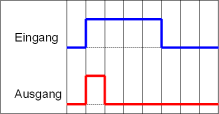Wiping contact
Wiper contact (short: wiper ) is the name for an electronic or electromechanical component or an electronic circuit which, as a reaction to a pulse at the input, delivers a one-time pulse with a defined amplitude and a defined duration (pulse width) at the output.
The start of the output pulse occurs after a logical change in the input signal level (edge detection). The output pulse can be generated electronically or electromechanically. It remains in place for a predefined time regardless of the input signal.
If the input signal is present longer than the output pulse, the wiper contact has a signal-shortening effect. If the input signal is shorter than the output pulse, the wiper contact extends the signal.
Depending on the output- activating signal edge, a distinction is made between switch-on wiper contacts (output pulse starts with a rising edge at the beginning of the input level) and switch-off wipe contacts (output pulse starts with a falling edge at the end of the input level).
variants
- Switch-on wiper contact or relay : output pulse with incoming input signal ( L / H edge )
- Switch-off wiper contact or relay: output pulse with outgoing input signal ( H / L edge )
- Combination of both behavior: output pulse for incoming as well as outgoing input signal
| Circuit symbols | Pulse Diagrams | |
|---|---|---|
|
|
Pulse contact Contact when actuated |

|
|
|
Pulse contact Contact on relapse |

|
|
|
Pulse contact Contact on actuation and release |

|
Use of terms
While originally only mechanical components such. For example, certain relays or switches were referred to as wipers (to generate the pulse, a contact “wipes” its counterpart there), the term is now also used in connection with other components or functions. In electronics, for example, non-retriggerable monoflops are sometimes referred to as wipers due to the same initial behavior . The term also appears in software technology , for example bits are often referred to as wipers in a PLC if they are only set for one program cycle and are therefore used for edge detection.
Application examples
- Generation of defined impulses from mechanical contact actuations or signals of variable length
- Automatic staircase light
- Wiper relays that are designed in such a way that they respond reliably even to very short input pulses
- Two- hand operation for presses and the like - 2 switches must be operated simultaneously; this ensures that both hands are out of the danger area
See also
literature
- Günter Wellenreuther, Dieter Zastrow: Control technology with PLC. Vieweg + Teubner Verlag, 1988, ISBN 978-3528445805 , p. 69 ( limited preview in Google book search).
